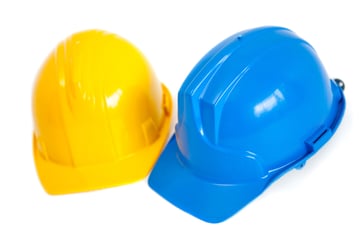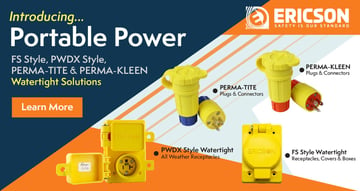Whether you’re working on a construction, renovation, or industrial project, reliable temporary power solutions are essential. Not only do they keep work moving quickly and efficiently, they ensure worker safety and code compliance. As federal and local regulations regarding jobsite safety evolve and become stricter, it’s vital to understand the best way to set up and maintain compliant temporary power systems.
In this blog post, you’ll get actionable tips on how to ensure compliance with NEC (National Electric Code) and OSHA (Occupational Safety and Health Administration) standards. Whether you need an industrial portable power station, a complete jobsite power station, or help managing temporary wiring and distribution, this will help you stay compliant with all the necessary requirements.
Why Temporary Jobsite Power Compliance Matters
Temporary power systems tend to be exposed to harsh environments and frequent use. They’re constructed to handle high foot traffic, unpredictable weather, and ever-changing worksites. These are often seen at construction sites using portable power stations.
There are serious consequences for failing to follow OSHA and NEC guidelines. Safety hazards are the main concern, as poor lighting can lead to electrocution and arc flash. Equipment damage and inefficiencies lead to more delays, while fines and jobsite shutdowns can cause serious delays.
Here are some of the best ways to keep your temporary jobsite power setup compliant, safe, and smart.
Understand the Applicable NEC Articles
The NEC governs electrical installations in the U.S., and Article 590 specifically addresses temporary installations. It states that all conductors and equipment must be rated for the conditions they’ll be used in. Unless granted an extension, temporary wiring should not be used for more than 90 days. If you have receptacles in damp or outright wet locations, you must use ground-fault circuit interruptors (GFCIs). Finally, any temporary power must be removed promptly once work is completed.
Always reference the latest NEC codebook and be sure to cross-check local amendments. When in doubt, reach out to a licensed electrician with experience working on similar projects, and see what they have to say.
Comply With OSHA’s Temporary Wiring Standards
OSHA 29 CFR 1926.405 and related standards cover temporary wiring practices on construction sites. These regulations are designed to reduce the risk of shock, fire, and equipment failure.
Key OSHA requirements include:
- Use of GFCI protection or an Assured Equipment Grounding Conductor Program (AEGCP) to monitor grounding reliability
- Protection of flexible cords and cables from damage due to physical stress, sharp objects, and moisture
- Prohibition of using extension cords as permanent wiring
- Clear labeling of panels and disconnects
All components of a temporary jobsite power system must be OSHA-approved, and make sure they’re built for industrial use cases.
Choose Industrial-Grade Equipment Designed for Compliance
In order to maintain a safe and compliant power setup, it’s important to use certified, ruggedized components. Opt for industrial portable power stations rated especially for outdoor and wet environments. You must use heavy-duty cables with UL listings for temporary sites. If you’re using weatherproof panels or distribution boxes, make sure they are NEMA-rated and appropriate for the worksite. Integrating GFCI breakers into all distribution points is another must if you want to stay compliant.
Plan Your Layout for Safety and Efficiency
Make sure the layout of your worksite is deliberate, thoughtful, and designed for safety and efficiency. If you have high-traffic walkways, keep them clear of cords, boxes, and other debris. It’s important to mount distribution equipment off the ground, which helps to prevent water intrusion that can lead to serious damage. Lighting and power circuits must be separated to keep potential overloads from spreading. Finally, color-coded cords and panel connections make for easy and fast identification.
Grounding and Bonding: Your First Line of Defense
Improper grounding is one of the top causes of electrical accidents on job sites. It’s absolutely vital to remain compliant with both NEC and OSHA requirements when it comes to effective bonding and grounding. This includes driving proper grounding rods and verifying continuity, periodically testing using ground resistance testers, and bonding all conduits and metal enclosures directly to the grounding electrode electrode system.
If possible, choose a jobsite power station that comes with built-in grounding terminals. This helps to simplify compliance and reduce risks.
Regular Inspections and Documentation
To keep your temporary power setup running smoothly, regular maintenance is a must. OSHA has strict requirements regarding routine inspections, especially if your site is using an Assured Equipment Grounding Conductor Program.
Your inspection regime should be thorough and consistent. Every day, check for visual signs of damage or wear. Grounding conductors should get weekly continuity checks. Keep a detailed log of each inspection and the results, as well as how you corrected the issues. Whenever you discover a worn or damaged component, replace it as quickly as possible.
You can reduce manual checks by using automated jobsite power solutions; many come with smart diagnostics that help assist with compliance documentation, too.
Train Your Crew on Safe Power Use
It’s essential your team understands how to safely operate your temporary jobsite power setup. Your team will need to learn proper connection and disconnection procedures, as well as safe use of extension cords and portable equipment. Team members should be able to recognize signs of electrical failure and know to immediately report unsafe conditions.
Safety training should be a regular part of your onboarding program, but it doesn’t stop there. Refresher courses should be given on a scheduled basis to keep everyone safe and compliant.
Use Modular Systems for Future-Proofing
In the world of construction, you need to be able to adapt to environmental changes fast. Using modular scalable systems, like high-capacity industrial portable power stations, lets you adjust quickly and still stick to code compliance.
Plug-and-play expandability, quick-connect camlock systems, and stackable or rack-mounted panels are all features to keep an eye out for. Best of all, some systems come with pre-configured OSHA and NEC compliant kits. All these tools help you to grow your temporary power system to match your project, without worrying about safety risks.
Ericson Solutions for Temporary Jobsite Power Compliance
Staying compliant with NEC and OSHA is a continuous and ongoing process. It involves planning, training, inspecting, and adjusting as the situation dictates.
The right tools can help reduce stress and make staying compliant much easier. Whether you’re deploying a full jobsite power station or need multiple industrial portable power stations, make sure your equipment is rated, your team trained, and your documentation up to date.
A well-designed temporary jobsite power system can boost efficiency, ensure worker safety, and protect your company from liability. Remember, compliance is about more than just meeting codes; it’s about creating a jobsite culture of safety, performance, and productivity.
For over a century, Ericson has led the industry in electrical safety innovation, delivering rugged, code-compliant power distribution solutions built to endure the demands of the jobsite. From large-scale construction zones to mobile field operations, our industrial portable power stations and jobsite power stations are engineered to meet NEC and OSHA standards.
Every Ericson product is designed with worker safety in mind. Our products come with third-party certifications (UL, ETL, CSA, QPS) and stick strictly to NEC/CEC codes.
Whether you're powering up a temporary jobsite or planning for scalable growth, Ericson offers the tools, distribution panels, and lighting systems to help your team stay safe, efficient, and inspection-ready.
Find the Right Lighting for Your Jobsite
Explore Ericson’s full line of industrial LED lighting today, or contact our team for help selecting the best option based on your site’s requirements.Our lights meet or exceed OSHA and NEC standards, and their rugged designs are made to handle the real conditions of your jobsite. With Ericson, you’re not just getting lights; you’re getting confidence, compliance, and value that lasts.
Tag(s):
Brian Earl
Hailing from Minnesota originally, Brian began his secondary education at the University of Minnesota with his undergraduate work and his MBA in Management at University of Michigan, focusing on strategic marketing and market planning. He has an extensive background in developing and leading a variety of marketing,...
More from the blog
View All Posts
Certifications and Regulations
7 min read
| April 12, 2024
Importance of Worker Safety using Safe, Code Compliant Portable Power
Read More.jpg?length=360&name=GFCI%20Solutions%20Launch%20Social%20and%20Blog%20(2).jpg)
New Product Launch
6 min read
| December 13, 2022
Ericson Launches Upgraded GFCI Solutions: Ensuring Worker Safety
Read More
New Product Launch
8 min read
| March 21, 2024
Invest in Ericson Watertight Solutions for Your Portable Power Needs
Read MoreSubscribe to blog updates
Stay up-to-date on what's happening at this blog and get additional content about the benefits of subscribing.
